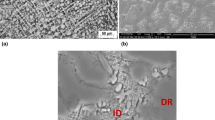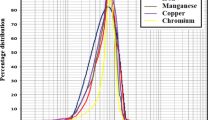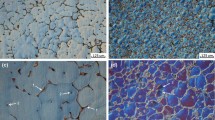Abstract
This paper describes the effect of temperature (85 °C) and relative humidity (RH) (85%) on structure and material properties of an environmental-friendly Sn–3.0Ag–0.5Cu, in wt.% (SAC305) material. A detail microstructure characterization was performed by scanning electron microscope with EDS analysis, X-ray diffraction, electron backscattered diffraction and transmission electron microscope techniques. From this structural analysis, it is evident that in the as-cast alloy, submicron-sized acicular and spherical-shaped ε-Ag3Sn and very fine η-Cu6Sn5 intermetallic compound (IMC) particles are homogeneously distributed in fine β-Sn matrix grains. However, after exposing SAC305 alloy to 85 °C and 85% RH for 60 days, the coarsening of its microstructure was observed changing significantly the morphology (size and shape) of the IMCs as well as of the Sn matrix. The Sn matrix grains size (in diameter) in as-cast alloy ranges within 20–30 µm, while after heat treatment an increase in size of 35–45 µm was observed. Furthermore, the ε-Ag3Sn IMC particles appeared with coarse structure. Therefore, the mechanical properties of SAC305 material turned inferior that confirmed by electrical resistivity and mechanical properties measurements. The electrical resistivity and microhardness values were reduced by about 11.2% and 22%, respectively, with respect to the corresponding values of the reference alloy (as-cast alloy). However, the heat-treatment method enhanced the damping properties of SAC305 material.










Similar content being viewed by others
References
Abtew M, Selvaduray G (2000) Lead-free solders in microelectronics. Mater Sci Eng R 27:95–141
Xiong MY, Zhang L (2019) Interface reaction and intermetallic compound growth behavior of Sn–Ag–Cu lead-free solder joints on different substrates in electronic packaging. J Mater Sci 54(2):1741–1768. https://doi.org/10.1007/s10853-018-2907-y
Gain AK, Fouzder T, Chan YC, Sharif A, Yung WKC (2010) Investigation of small Sn–3.5 Ag–0.5 Cu additions on the microstructure and properties of Sn–8Zn–3Bi solder on Au/Ni/Cu pads. J Alloys Compd 489:678–684
Ma H, Suhling JC (2009) A review of mechanical properties of lead-free solders for electronic packaging. J Mater Sci 44:1141–1158. https://doi.org/10.1007/s10853-008-3125-9
Chen G, Wu F, Liu C, Silberschmidt VV, Chan YC (2016) Microstructures and properties of new Sn-Ag-Cu lead-free solder reinforced with Ni-coated graphene nanosheets. J Alloys Compd 656:500–509
Chi CC, Chuang TH (2006) Intermetallic reactions in Sn–3.5Ag solder ball grid array packages with Ag/Cu and Au/Ni/Cu pads. J Electron Mater 35(3):471–478
Gain AK, Chan YC, Ahmed Sharif A, Yung WKC (2009) Effect of small Sn–3.5Ag–0.5Cu additions on the structure and properties of Sn–9Zn solder in ball grid array packages. Microelectron Eng 86(11):2347–2353
Kotadia HR, Howes PD, Mannan SH (2014) A review: on the development of low melting temperature Pb-free solders. Microelectron Reliab 54:1253–1273
Plevachuk Y, Hoyer W, Kaban I, Kohler M, Novakovic R (2010) Experimental study of density, surface tension, and contact angle of Sn–Sb-based alloys for high temperature soldering. J Mater Sci 45:2051–2056. https://doi.org/10.1007/s10853-009-4120-5
Gain AK, Zhang L (2016) Interfacial microstructure, wettability and material properties of nickel (Ni) nanoparticle doped tin-bismuth-silver (Sn–Bi–Ag) solder on copper (Cu) substrate. J Mater Sci: Mater Electron 27:3982–3994
Miller CM, Anderson IE, Smith JF (1994) A viable tin-lead solder substitute: Sn–Ag–Cu. J Electron Mater 23(7):595–601
Schmetterer C, Ipser HJ (2008) Pearce Handbook of properties of SAC solders and joints. In ELFNET COST 531, Lead free solders, vol 2, Brussels, 2008
El-Daly AA, El-Taher AM, Gouda S (2015) Development of new multicomponent Sn–Ag–Cu-Bi lead-free solders for low-cost commercial electronic assembly. J Alloys Compd 627:268–275
Gain AK, Zhang L, Quadir MZ (2016) Thermal aging effects on microstructures and mechanical properties of an environmentally friendly eutectic tin–copper solder alloy. Mater Des 110:275–283
Gain AK, Zhang L, Chan YC (2015) Microstructure, elastic modulus and shear strength of alumina (Al2O3) nanoparticles-doped tin-silver-copper (Sn–Ag–Cu) solders on copper (Cu) and gold/nickel. J Mater Sci Mater Electron 26(9):7039–7048
Novakovic R, Lanata T, Delsante S, Borzone G (2012) Interfacial reactions in the Sb–Sn/(Cu, Ni) systems: wetting experiments. Mater Chem Phys 137:458–465
Gain AK, Zhang L (2016) Growth mechanism of intermetallic compound and mechanical properties of nickel (Ni) nanoparticle doped low melting temperature tin-bismuth (Sn-Bi) solder. J Mater Sci Mater Electron 27(1):781–794
Zhang L, Tu KN (2014) Structure and properties of lead-free solders bearing micro and nano particles. Mater Sci Eng R 82:1–32
Moon K-W, Boettinger WJ, Kattner UR, Biancaniello FS, Handwerker CA (2000) Experimental and thermodynamic assessment of Sn–Ag–Cu solder alloys. J Electron Mater 29:1122–1236
Giuranno D, Delsante S, Borzone G, Novakovic R (2016) Effects of Sb addition on the properties of Sn–Ag–Cu/(Cu, Ni) solder systems. J Alloys Compd 689:918–930
Lewis D, Allen S, Notis M, Scotch A (2002) Determination of the eutectic structure in the Ag–Cu–Sn system. J Electron Mater 31(2):161–167
Chen G, Wu F, Liu C, Xia W, Liu H (2016) Effects of fullerenes reinforcement on the performance of 96.5Sn–3Ag–0.5Cu lead-free solder. Mater Sci Eng A 636:484–492
Gain AK, Zhang L (2016) Microstructure, mechanical and electrical performances of zirconia nanoparticles-doped tin-silver-copper solder alloys. J Mater Sci Mater Electron 27(7):7524–7533
Gain AK, Zhang L (2016) Harsh service environment effects on the microstructure and mechanical properties of Sn–Ag–Cu–1 wt% nano-Al solder alloy. J Mater Sci Mater Electron 27(11):11273–11283
Mehrabi K, Khodabakhshi F, Zareh E, Shahbazkhan A, Simchi A (2016) Effect of alumina nanoparticles on the microstructure and mechanical durability of meltspun lead-free solders based on tin alloys. J Alloys Compd 688:143–155
Chan YC, Yang D (2010) Failure mechanisms of solder interconnects under current stressing in advanced electronic packages. Prog Mater Sci 55:428–475
Gain AK, Zhang L (2017) Effect of thin gold/nickel coating on the microstructure, wettability and hardness of lead-free tin-bismuth-silver solder. J Mater Sci Mater Electron 28(6):4885–4896
Chang YW, Chiu SH, Chen C, Yao DJ (2011) Effect of Si-die dimensions on electromigration failure time of flip-chip solder joints. Mater Chem Phys 127:85–90
Tu KN (2011) Reliability challenges in 3D IC packaging technology. Microelectron Reliab 51:517–523
Hsiao HY, Chen C (2009) Thermomigration in Pb-free SnAg solder joint under alternating current stressing. Appl Phys Lett 94:1–3
Huang AT, Gusak AM, Tu KN, Lai YS (2006) Thermomigration in SnPb composite flip chip solder joints. Appl Phys Lett 88:141911
Adawiyah MAR, Azlina OS (2018) Comparative study on the isothermal aging of bare Cu and ENImAg surface finish for Sn–Ag–Cu solder joints. J Alloys Compd 740:958–966
Chen G, Peng H, Silberschmidt VV, Chan YC, Liu C, Wu F (2016) Performance of Sne3.0Ag–0.5Cu composite solder with TiC reinforcement: physical properties, solderability and microstructural evolution under isothermal ageing. J Alloys Compd 685:680–689
Ahmed S, Wu J, Fu N, Suhling JC, Lall P (2018) Quantification and modeling of microstructural evolution in lead free solders during long term isothermal aging. In: Proceedings of the 68th IEEE electronic components and technology conference (ECTC), pp 162–171
Ahmed S, Hasnine Md, Suhling JC, Lall P (2017) Mechanical characterization of SAC solder joints at high temperature using nanoindentation. In: Proceedings of the 67th IEEE electronic components and technology conference (ECTC), pp 1128–1135
Lee JE, Kim KS, Inoue M, Jiang J, Suganuma K (2008) Effects of Ag and Cu addition on microstructural properties and oxidation resistance of Sn–Zn eutectic alloy. J Alloys Compd 454:310–320
Gain AK, Zhang L (2014) Microstructure, thermal analysis and damping properties of Ag and Ni nano-particles doped Sn–8Zn–3Bi solder on OSP-Cu substrate. J Alloys Compd 617:779–786
Chawla N (2009) Thermomechanical behaviour of environmentally benign Pb-free solders. Int Mater Rev 54(6):368–384
Zhang Y, Zhu H, Fujiwara M, Xu J, Dao M (2013) Low-temperature creep of SnPb and SnAgCu solder alloys and reliability prediction in electronic packaging modules. Scr Mater 69:607–610
Chang SH, Wu SK (2010) Damping characteristics of Sn–3Ag–0.5Cu and Sn–37Pb solders studied by dynamic mechanical analysis. Scr Mater 63:957–960
Maleki M, Cugnoni J, Botsis J (2016) Multi-scale modeling of elasto-plastic response of SnAgCu lead-free solder alloys at different ageing conditions: effect of microstructure evolution, particle size effects and interfacial failure. Mater Sci Eng A 661:132–144
Massalski TB, Murray JL, Bennett LH, Baker H (1986) Binary alloy phase diagrams, vol 2 and 1. American Society for Metals, ASM, Metals Park
Laurila T, Vuorinen V, Kivilahti JK (2005) Interfacial reactions between lead-free solders and common base materials. Mater Sci Eng R 49(1–2):1–60
Kang SK, Choi WK, Shih DY, Henderson DW, Gosselin T, Sarkhel A, Goldsmith C, Puttlitz KJ (2003) Ag3Sn plate formation in the solidification of near-ternary eutectic Sn–Ag–Cu. JOM 55(6):61–65
Amin NAAM, Shnawah D, Said SM, Sabri MFM, Arof H (2014) Effect of Ag content and the minor alloying element Fe on the electrical resistivity of Sn–Ag–Cu solder alloy. J Alloys Compd 599:114–120
Sabri MFM, Nordin NIM, Said SM, Amin NAAM, Arof H, Jauhari I, Ramli R, Weide-Zaage K (2015) Effect of thermal aging on the electrical resistivity of Fe-added SAC105solder alloys. Microelectron Reliab 55:1882–1885
Sutou Y, Omori T, Koeda N, Kainuma R, Ishida K (2006) Effects of grain size and texture on damping properties of Cu–Al–Mn-based shape memory alloys. Mater Sci Eng A 438–440:743–746
Acknowledgements
Authors acknowledge the funding body of UNSW for the Project InfoEd Ref: RG124326. We are also thankful to Mr. Tit Wah Chan, Department of Physics and Materials Science, CityU, for helping the damping property test. We would like to thank to Dr Zhonghuai Wu, School of Mechanical and Manufacturing Engineering, UNSW for assisting the nanoindentation test.
Author information
Authors and Affiliations
Corresponding author
Ethics declarations
Conflict of interest
The authors declare that they have no conflict of interest.
Additional information
Publisher's Note
Springer Nature remains neutral with regard to jurisdictional claims in published maps and institutional affiliations.
Rights and permissions
About this article
Cite this article
Gain, A.K., Zhang, L. Temperature and humidity effects on microstructure and mechanical properties of an environmentally friendly Sn–Ag–Cu material. J Mater Sci 54, 12863–12874 (2019). https://doi.org/10.1007/s10853-019-03784-2
Received:
Accepted:
Published:
Issue Date:
DOI: https://doi.org/10.1007/s10853-019-03784-2




